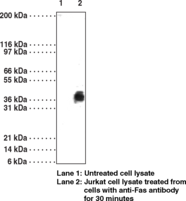Antigen:
synthetic peptide corresponding to the caspase-3 mediated cleavage site of IκBα
·
Clone designation:
5D1623
·
Host:
mouse
·
Isotype:
IgG1
·
Application(s):
WB
·
NF-κB is silenced in the cytoplasm by an inhibitory protein IκB.1 Synthesis of IκBα is autoregulated.2 IκB proteins are phosphorylated by IκB kinase complex consisting of at least three proteins, IKK1/α, IKK2/β, and IKK3/γ.3,4,5,6 External stimuli such as tumor necrosis factor or other cytokines induce phosphorylation and degradation of IκB releasing NF-κB dimers. NF-κB dimers subsequently translocate to the nucleus and activate target genes. Six members of the IκB family have been identified.1 IκBa can be cleaved by caspases during apoptosis to produce an amino-terminal truncated IκBa (ΔN-IκBα).7,8 The ΔN-IκBα is resistant to degradation in response to inducers of NF-κB and act as a dominant inhibitory molecule that suppresses NF-κB activity during apoptosis.
1
Verma, I.M., Stevenson, J.K., Schwarz, E.M., et al. Rel/NF-κB/IκB family: Intimate tales of association and dissociation. Genes Dev 9 2723-2735 (1995).
2
Verma, I.M., and Stevenson, J. IκB kinase: Beginning, not the end. Proc Natl Acad Sci USA 94 11758-11760 (1997).
3
DiDonato, J.A., Hayakawa, M., Rothwarf, D.M., et al. A cytokine-responsive IκB kinase that activates the transcription factor NF-κB. Nature 388 548-554 (1997).
4
Régnier, C.H., Song, H.Y., Gao, X., et al. Identification and characterization of an IκB kinase. Cell 90 373-383 (1997).
5
Mercurio, F., Zhu, H., Murray, B.W., et al. IKK-1 and IKK-2: Cytokine-activated IκB kinases essential for NF-κB activation. Science 278(5339) 860-866 (1997).
6
Yamaoka, S., Courtois, G., Bessia, C., et al. Complementation cloning of NEMO, a component of the IκB kinase complex essential for NF-κB activation. Cell 93 1231-1240 (1998).
7
Barkett, M., Xue, D., Horvitz, H.R., et al. Phosphorylation of IκNα inhibits its cleavage by caspase CPP32 in vitro. J Biol Chem 272(47) 29419-29422 (1997 Nov 21 1997).
8
Reuther, J.Y., and Baldwin, A.S. Apoptosis promotes a caspase-induced amino-terminal truncation of IκBα that functions as a stable inhibitor of NF-κB. J Biol Chem 274 20664-20670 (1999).






